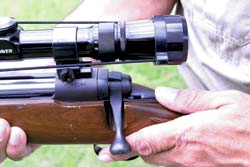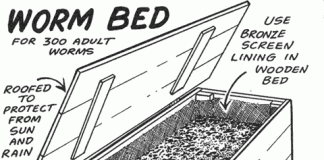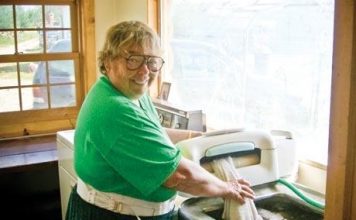 |
|
| Website Exclusive • July, 2008 |
Fifty years ago, Savage Arms introduced a new bolt-action sporting rifle. In the gun world, this was news. Savage was most famous for its sleek lever action Model 99, named for the year of its introduction at the end of the 19th century. The firm had produced a few bolt actions, but they tended to be undistinguished in styling and performance, and were seen as “poor man’s hunting rifles.”
|
The new rifle, dubbed the Model 110, was different. It was built to run after the big dog, Winchester’s Model 70, long known colloquially in gun circles as “the rifleman’s rifle.” The 110’s design work, begun in 1956, was done primarily by the late Nicholas Brewer. Brewer had sought to design a reliable bolt action arm with superior accuracy and an affordable price. Firearms engineers have since marveled at the brilliance with which Brewer combined economy of manufacture with quality of end-user function.
In his authoritative text “Bolt Action Rifles,” Frank de Haas explained in great detail how much cleverness had gone into Brewer’s design of the Model 110’s action. Here’s an example: “The 110 sear, a marvel of ingenuity, serves a 3-fold function: as sear, bolt stop and cocking indicator,” de Haas pointed out.
There were two other factors that caught the gun-buying public’s attention and assured that the new rifle would stay on the production line for the next half century. Introduced in 1958, the gun was quickly made available in a left-handed model, and in 1962, the company made actions and barreled actions available separately.
Southpaw factor
Since the inception of the bolt action rifle in the 19th century, the bolt had always been on the right side, intended for operation by a right-handed, right eye dominant shooter. Converting one for left-handed use was a highly expensive custom gunsmithing proposition. Brewer, from the beginning, designed the rifle to be manufactured with either right-handed or left-handed bolt handle. The ingenuity of the design is that it is not mirror image in the southpaw versus northpaw models: in each, for instance, the bolt stop/takedown lever is on the right side of the receiver, or action housing.
|
Various estimates indicate that somewhere between one-sixth and one-twelfth of the human population is left-handed. There are many other people who are right-handed but left eye dominant, and are better off shooting from their left shoulder. Firing from the left shoulder with the bolt’s operating handle on the right side of the rifle can be extremely awkward. The Savage Model 110 was the very first production rifle manufactured for lefties, with the bolt handle on the port side of the gun.
Most Mauser type actions (and, like the Winchester Model 70, the Savage Model 110 was at its core a Mauser type rifle) had the manual safety at the right rear of the action, to give ready access to a right-handed shooter’s thumb. Nick Brewer designed the Model 110 with a tang safety, a sliding switch on the tang, or the part of the rifle’s action that mated with the top edge of the wooden stock. Push it forward to fire, slide it back for “on safe.” Since the coming of the double barrel “hammerless” shotgun in the previous century, this system had been familiar to sportsmen around the world, and those in the United States were no exception. They appreciated a high-powered rifle that worked the same way.
And, of course, the tang safety is ambidextrous, equally accessible to right hand or left. Indeed, many of us right-handed shooters have found it more natural and quick to operate than the three-position “flipper” at the right rear of the Model 70’s action. This type of manual safety would later be copied in other fine rifles, from the first iteration of the Ruger Model 77 to the new Browning X-Bolt.
Custom rifle factor
|
The 1950s was a time when it was hugely popular for shooters to “sporterize” bolt action military rifles, which were flooding the market. Since new “sporter barrels,” lighter and more tapered than heavy duty military rifle barrels, were desirable, some importers simply removed the barrels from the cruddier military surplus guns, and just sold the actions, knowing that gunsmiths and home hobbyists were going to install new barrels anyway. Because military stocks tended to be heavy, bulky, ugly, and unnecessarily long at the front, the first step in “sporterizing” was often putting the barrel and action into some new wood. Thus, “barreled actions” were also popular on the surplus market.
Winchester, Remington, et. al. would not sell just the action or the barreled action. They figured, correctly enough from a commercial standpoint, that there was more profit in selling a fully assembled rifle. However, the individual who wanted a customized rifle with a modern, American-made action or action and barrel would now have to pay full price for a whole rifle, only to throw away the stock and replace it with a newly purchased one. Savage saw a market here, and wisely went for it.
Their 1962 announcement that they would sell actions and barreled actions separately, for much less than the cost of a whole rifle, was a brilliant move. It endeared them to gunsmiths and gun shops with gunsmithing services, because it brought in more business.
But, more than anything else, it was the affordability of the Model 110 combined with its outstanding performance that kept it in the hands of outdoorsmen and on the racks of gun shops.
Cost factor
Savage expressly designed the Model 110 to shoot just as well asand even outshootthe iconic Model 70 Winchester, and to do it at a markedly lower price point. They succeeded. In 1962, Remington introduced their Model 700, which would quickly outstrip the Winchester in popularity and become the best-selling modern bolt action rifle ever. Savage kept performance pace with the Remington 700and undersold it too.
|
In 1966, when the 110 received a slight design upgrade, it still distinctly undersold the competition. The Remington Model 700 bolt action started at $129.95 manufacturer’s suggested retail price (MSRP) then, and the Winchester Model 70 at $149.95. By contrast, the shooter could buy a Savage Model 110 new for as little as $102.50, according to the 1966 edition of the annual Gun Digest.
Today, a Hunter Series rifle from Savage starts at an MSRP of $564, including Savage’s Accu-Trigger, about which more shortly. By contrast, the lowest MSRPs I can find on the Net for the current “big three” of bolt action rifles are $779 for the all-weather version of the Ruger 77 Mark II, $900 for the Remington Model 700 BDL, and $999 for the latest reincarnation of the Winchester Model 70. It appears that the Savage 110 series is currently an even better value, proportionately, than it was when it was introduced in 1958.
What the experts say
Those who’ve actually worked with the 110 love its performance, even if they sometimes bemoan its pedestrian esthetics. One of my favorite rifle experts was always Clay Harvey, before he left the technical side of writing to become a novelist. In his excellent book, Popular Sporting Rifle Cartridges, the Model 110 series surfaces again and again as one of the best performers. Sample comments taken at random: “The Savage 110-V is an excellent choice for the varmint hunter looking for a bargain in a 22-250. The 110-V has an excellent reputation for accuracy.” “The author’s Savage Model 111 is the most accurate 250-3000 he’s ever owned. It averaged .99-inch for nine five-shot groups.” “The excellent Savage 110-S silhouette gun is available in .308; the author’s 110-S averages well under 1 inch for five shots.” As you read those lines, notice how often the words “excellent” and “accurate” are juxtaposed in the same sentence.
|
Such all-time great rifle experts as Jim Carmichel and the late Jack O’Connor certainly didn’t consider the 110 a prestige rifle, but both gave it high points for its accuracy. I’ve never seen the Savage’s bolt action reliability to function questioned by any authority.
What it lacks in snob appeal, the 110-series makes up for with performance. Hear the words of James Mock, in his article “Savage’s New Model 12 Long Range Precision Varminter,” which appeared in the December 2007 issue of Precision Shooting magazine. He wrote, “Many say that confession is good for the soul, and I must confess that I have never been a big fan of the Savage bolt action rifles. This prejudice is not based on experience with them, however.”
Mock continued, “For several years many of my friends have sung the praises of the accuracy of Savage rifles, but I steadfastly refused to give them a try.” He acquired a Model 12 version with H-S Precision composition stock, and mounted an 8X to 32X variable power Burris Signature telescopic sight. The rifle was chambered for the relatively new .204 Ruger cartridge. After working with the rifle and experimenting with some handloaded ammunition for enhanced accuracy, he wrote, “…I shot four, 3-shot groups at 100 yards that measured 0.408, 0.327, (and) 0.300 (inches).” The bold lettering is the author’s, not mine, but for that sort of superb accuracy, I think bold numbers are absolutely appropriate. Added Mr. Mock, “Bobby (Wroten) posted the best 100 yard group with a 0.255 inch 3-shot group at 100 yards.”
In a “popular priced,” out-of-the-box factory production rifle, that kind of performance is nothing less than superb. Author Mock said, “This RB/LP Savage Target Action so impressed me that I bought one.” He closed by saying of the Savage, “It has impressed all who have seen or fired it. I believe that Savage has a real winner.”
It’s the uncommon accuracy that makes new friends all the time for the Savage 110. During a shooting session with Steve Sager and Gail Pepin to get pictures for this article, I was able to use Steve’s heavy barrel Model 10 and his .308 Winchester handloads to put three bullets in three-eighths of one inch, with two through the same hole. Par for the course for the Savage 110 family.
To make a Savage 110
Back in the 1990s, Savage hit upon a plan to get some more publicity from the “gun writers,” we scribes who are regularly published in gun magazines. They would bring us to the factory in Westfield, Massachusetts, and not just give us the usual guided tour of the plant, but have us assemble our own rifle under the watchful eyes of their most skillful master craftsmen.
|
I was a bit dubious about this. I have a mechanical IQ of about 50. My dad was a watchmaker with incredible dexterity and hand-eye coordination, but that gene sadly skipped my generation. (Yes, I can change a light bulb…but I need unlimited time, and may need to refer to the owner’s manual.)
The incredibly patient master craftsmen of Savage Arms got me through the process. Pausing only briefly to accidentally “drill and tap” my trigger finger, I managed to complete a lightweight, right-handed Model 110, caliber .308 Winchester, with a handsome and functional black composition stock. The amazing thing was that this rifle, just like the ones put together by the professionals, turned out to be able to crack the “gold standard” of the one-inch group at 100 yards, light sporter barrel and all.
My strongest memory of that experience was the melding of old and new in the factory. New Computer Assisted Design machinery, sitting alongside machines that had been in place since the first half of the 20th century, and above all the experienced eyes of the master craftsmen. Yes, they assessed barrel straightness and quality by eye, not just by computer, and they seemed to be invariably correct.
It was a triumph of man over machine, a paean to old world craftsmanship that existed in tandem with modern machine and computer technology. I mention it here because it’s the sort of thing I think the folks who read Backwoods Home Magazine will understand and appreciate.
Options
Over the years, the basic Savage Model 110 action has been the platform for many variations. Model numbers include Models 10, 11, 12, 111, 14, 114, 16, 116, 40, and 210, the latter actually being a 12 gauge shotgun slug gun. And I’ve probably missed a few variations. Calibers have included .204, .223, .22-250, .243, .270, .270 WSM (Winchester Short Magnum), 7mm-08, 7mm Remington Magnum, .308, .30-06, .300 Winchester Magnum, .300 WSM, and .338 Magnum and I may have missed some of those, too. From mouse to moose, there’s a Savage bolt action that chambers it. (If they made them in the elephant gun calibers, I guess that slipped by me, as well.) There’s even a muzzle-loading version, the Model 10ML. Savage has also produced a super-economy version carrying its lower-prestige sister brand, Stevens.
|
Prices start at $564 for the plain-Jane versions, and go all the way up to the 50th Anniversary Model, which features a high polished blue finish, great looking American Walnut traditional stock, and a price tag of $1,724. If that doesn’t sound in keeping with the original concept of an economy rifle for us ordinary Joe Citizens, well, I guess you’re allowed to splurge for your half-century anniversary.
Downsides
If the Savage 110 series is so good, why did it not overtake the Model 70 Winchester and particularly the super-popular Model 700 Remington as the all-time bestseller? I can identify perhaps four reasons: looks, perception, action feel, and trigger pull.
The Savage doesn’t strike most as a pretty gun. Its lines are unconventional, to the eyes of an experienced rifleman. The bolt truncates at the bolt handle, an odd appearance that assaults the eye of the connoisseur. That bolt handle drops straight down, like an old Mauser, and lacks the streamlined swept-back appearance that a couple of generation of hunters associate with modern rifles. The stamped trigger guard was just flat cheap- and ugly-looking from the beginning.
An American adage is, “You get what you pay for.” “Low-priced” is a phrase that too many take as a synonym for “cheap,” and that leads real soon to a perception of “shoddy,” which in this case is definitely a false perception. Earlier in this article, you met rifle expert James Mock, who sneered at the Savage 110 until he started shooting one and came to appreciate its fine accuracy. I can understand that; my experience was much the same. We’ll never know how many good shooters never became acquainted with this high-performing rifle because they wrote it off from the get-go as “a cheap gun that couldn’t be any good at that price.”
One element that touched both esthetics and value perception was the collared barrel design of the 110. The fluted lock-nut that surrounds the rear of the barrel as it emerges from the front of the receiver is just totally dissonant with the smooth, clean lines that rifle enthusiasts expect to see. This design was first used on an earlier Savage, the “el cheapo” Model 340, in calibers like .30-30 and .222 Remington. I was a kid when I came to realize this concept worked. I was in junior high when my dad bought me a used, 1950s vintage Model 340 .222 with a 1940s Weaver 440 scope. Lord, it was uglyand it had a trigger pull that felt like an exercise toolbut in my teens, I brought home frozen Butterballs from turkey shoots with it, competing against much more modern and sophisticated rifles. Part of that was a young guy’s hunger to win, and devotion to what he had learned from the books of the old masters, but some of it too was the inherent accuracy that Savage had built into that cheap rifle and its collared barrel before I was born. Later, when I got to know the Model 110, I came to realize that the old collar barrel concept Nick Brewer had borrowed from the Model 340 had worked then, and still worked now.
The action has never been as smooth as the competition from Remington, Ruger, and Winchester. It also takes an unusually firm upward shove to lift the bolt handle and begin the feeding cycle. This design element did not win the Savage any friends.
Finally, there is the matter of the trigger. In designing the 110 with cost-effective production as the key parameter, Brewer decided to put the sear a bit ahead of where it usually sits vis-à-vis the trigger in most high-performance bolt action rifles. This impaired leverage and was one reason why the 110 quickly earned a reputation for having a mediocre trigger pull. With performance-oriented shooters, who know the trigger is “the heart of the beast,” this was something close to a kiss of death.
|
Not readily adjustable by the owner (though aficionados could figure out how to do it, more or less), the 110’s trigger came out of the box heavier and with a little more of a grating feel, what shooters call “creep,” than most serious gun people wanted. It was a while before custom trigger makers like Timney came out with an aftermarket unit that would give a swe-e-et trigger pull.
Circa 2003, Savage solved that problem with a new design they called the Accu-Trigger. It’s an unconventional and ugly-lookin’ thingsomewhat like the 110 itself, some would saybut, my, oh my, it works! Trigger pull is now crisp and clean, adjustable down to the level that some marksmen just can’t do without in terms of lightness of pull, and there are no longer complaints about the trigger pull on a new Savage rifle.
For those who have the old model, there is the excellent Timney replacement trigger. I have used it and like it. Frankly, though, I for one grew accustomed to a long, heavy trigger pull on police service handguns years ago, so the old style Savage 110 trigger pull never bothered me that much. I learned that I got more leverage by placing my index finger at the distal joint on the trigger, instead of using the fingertip, and that made a huge amount of difference.
If you have an older Savage, you can improve your accuracy and hit potential greatly by simply changing to that distal joint contact of finger on trigger and rolling it back smoothly, like the double action pull on an old revolver, or like the trigger of a Glock pistol. If you don’t care for that, there is the outstanding Timney trigger retrofit. And if you’re buying your Savage new, the Accu-Trigger is superb anyway.
All of which, together, means there’s no longer a reason for the thinking rifle shooter to discount a bolt-action Savage of the 110 product family because of trigger pull issues. And as to the esthetics of the rifle, well, that’s a matter of preferring the sizzle to the steak.
Personal experience
I came late to the Savage 110. I had to shed my “gun snobbery” to appreciate it, and I had to actually shoot the damn things to make that happen.
I grew up in a time when the “minute of angle” rifle, the gun that would put every shot into an inch at 100 yards, was a holy grail. You pretty much had to send the rifle to a custom gunsmith to get that kind of accuracy, and if you had one that shot that tight, you cherished it like a family heirloom.
In that time, the Savage Model 110 was capable of shooting an inch at a hundred, out of the box, probably more often than not.
Technology caught up, with both the rifle makers and the ammo makers. Today, I know a lot of shooters who won’t give a rifle room on their gun rack if it doesn’t shoot minute of angle. Looking at the phenomenal groups James Mock achieved with his Savage .204 in the Precision Rifle test, it may be safe to assume that Savage has kept pace, and kept its edge ahead of most of its competition.
I own three Savage 110s today. One is my only left-handed bolt action rifle, a plain vanilla .30-06. Having sustained arm and hand injuries over the years, it seemed like a good idea to have one of my bolt guns that would work southpaw. I actually shoot it a little more accurately than my right-handed guns from offhand (standing without artificial support), perhaps because the dominant arm holds the fore-end steadier on target, and because I’m comfortable aiming with either eye. Still, I never did get enough repetitions in practice to make my left hand work the bolt as fast as my right hand can.
Another is that lightweight .308 I put together at the Savage plant under the best possible supervision. And another is the heavy barrel 110 FP .308 with Harris bipod that I would probably use if I knew I was going to have to make a “sniper shot” to protect some innocent person’s life, or if I was staking out a long bean field for venison. All three of these rifles will do an inch or better at a hundred yards with the ammo they like best, fulfilling the promise of accuracy that Nick Brewer designed into them, though the heavy barrel match-grade FP is, predictably, a little more accurate than the other two.
High performance. Low price. Solid value. Those are the hallmarks of the Savage 110 series, which has so thoroughly earned its longevity and its 50-year anniversary. They’re benchmark values of the “backwoods home” lifestyle, and worthy of tribute in these pages.






















